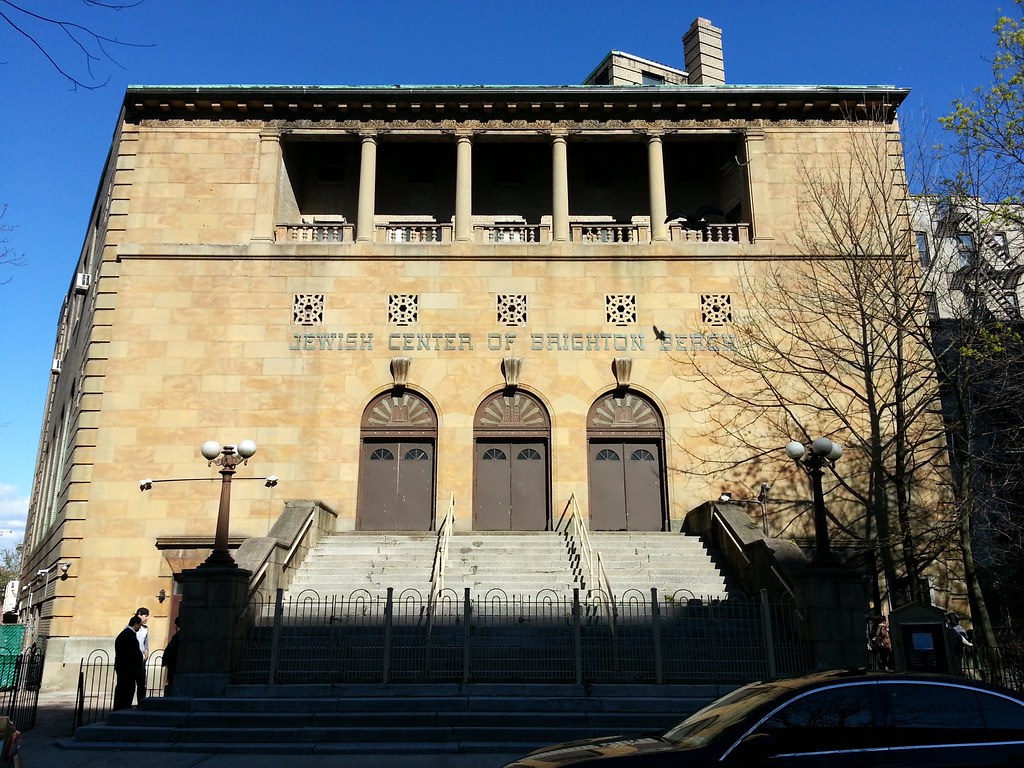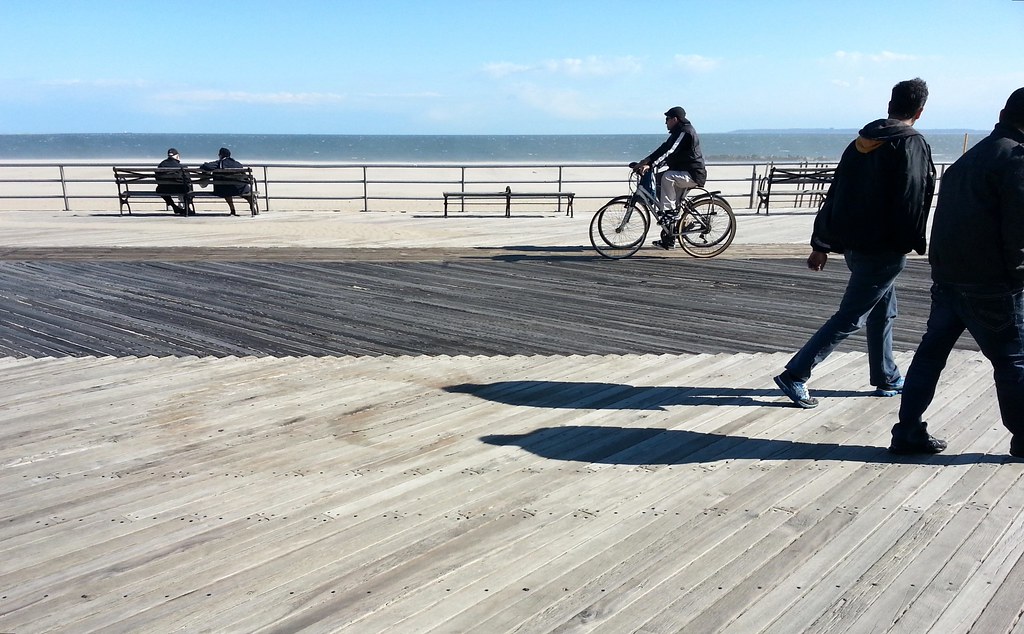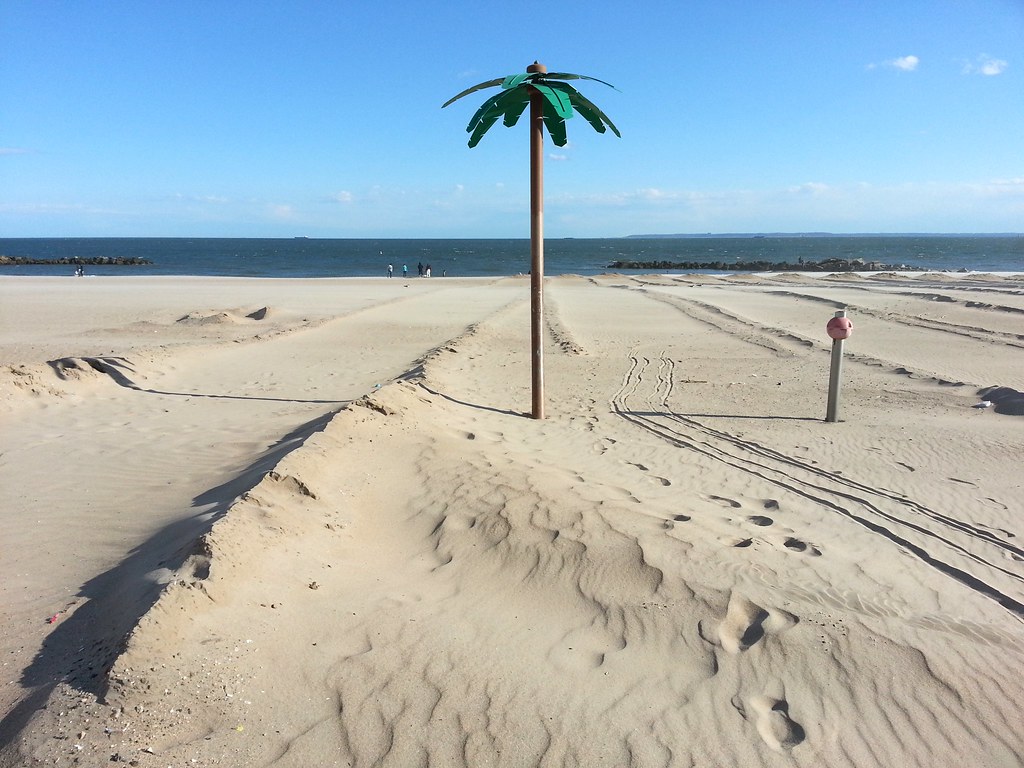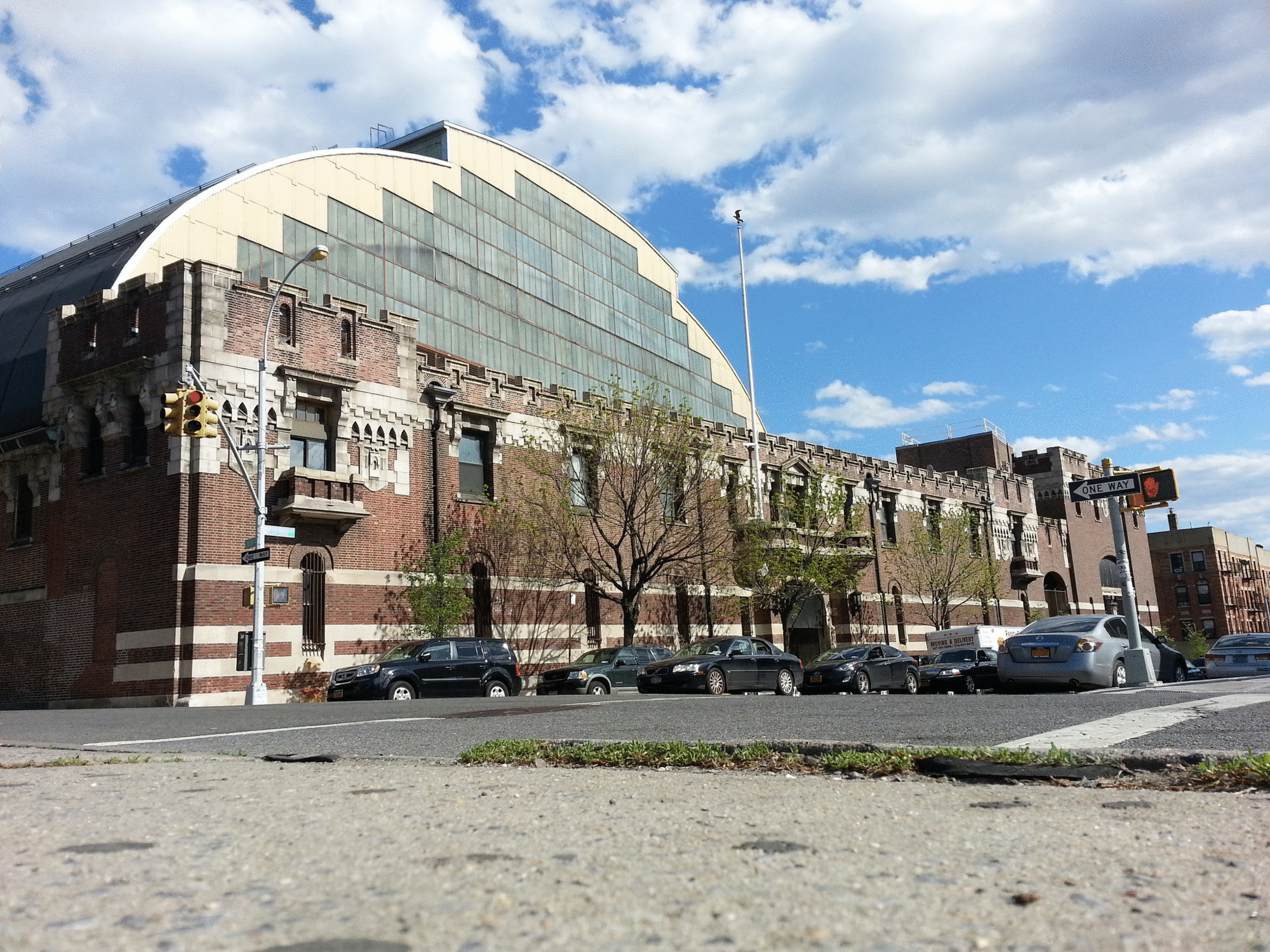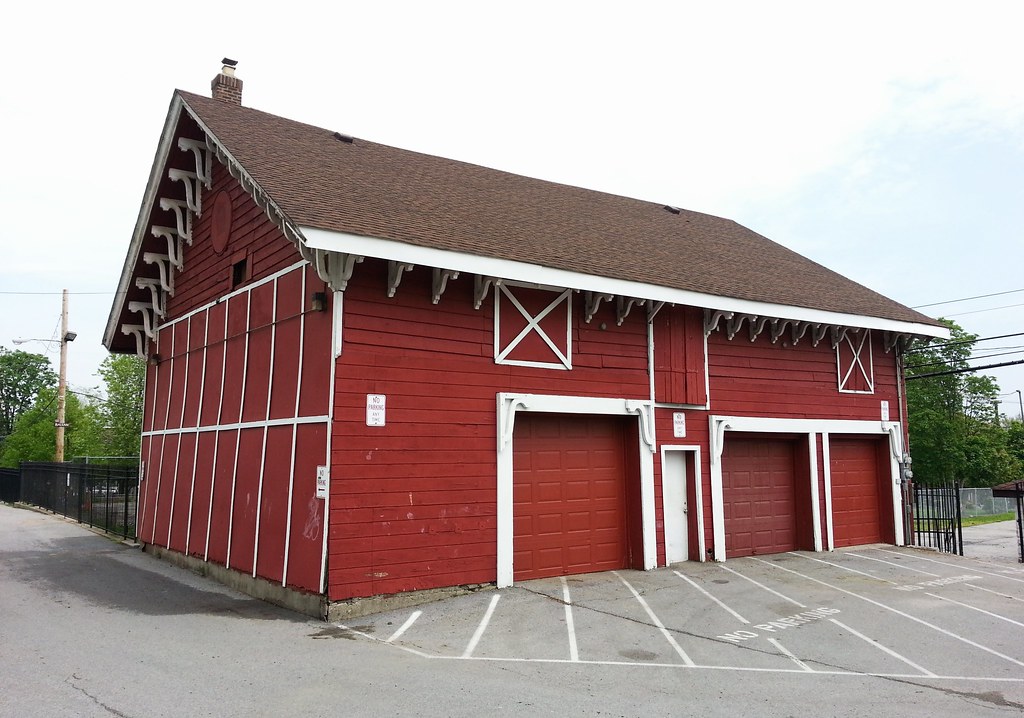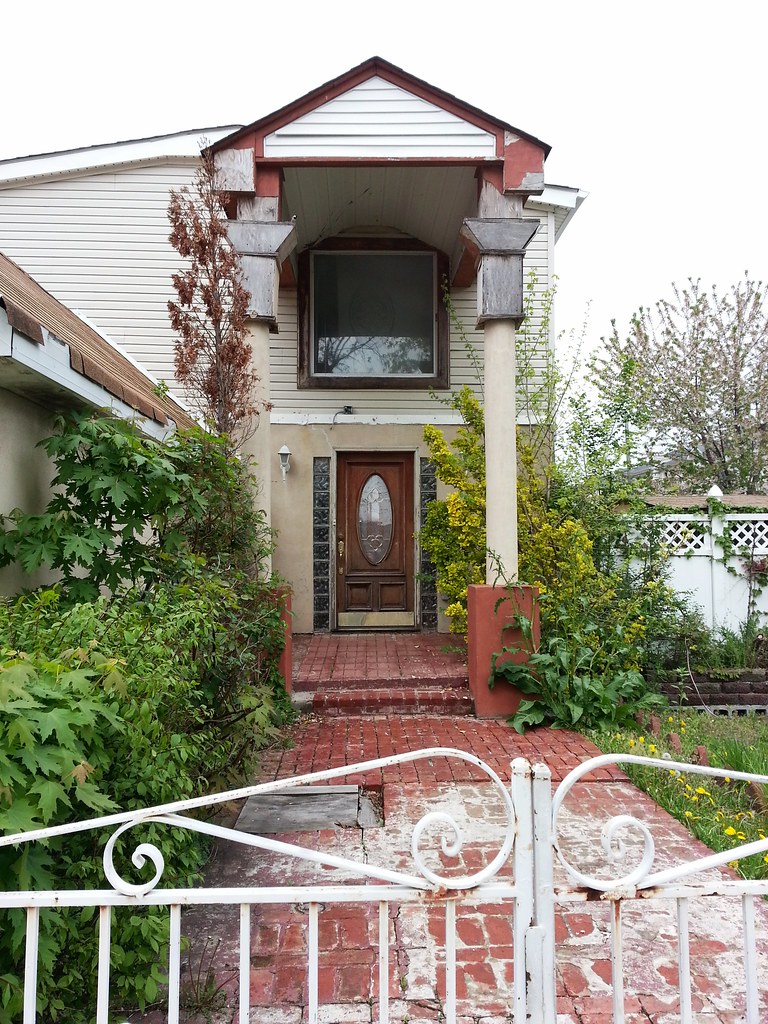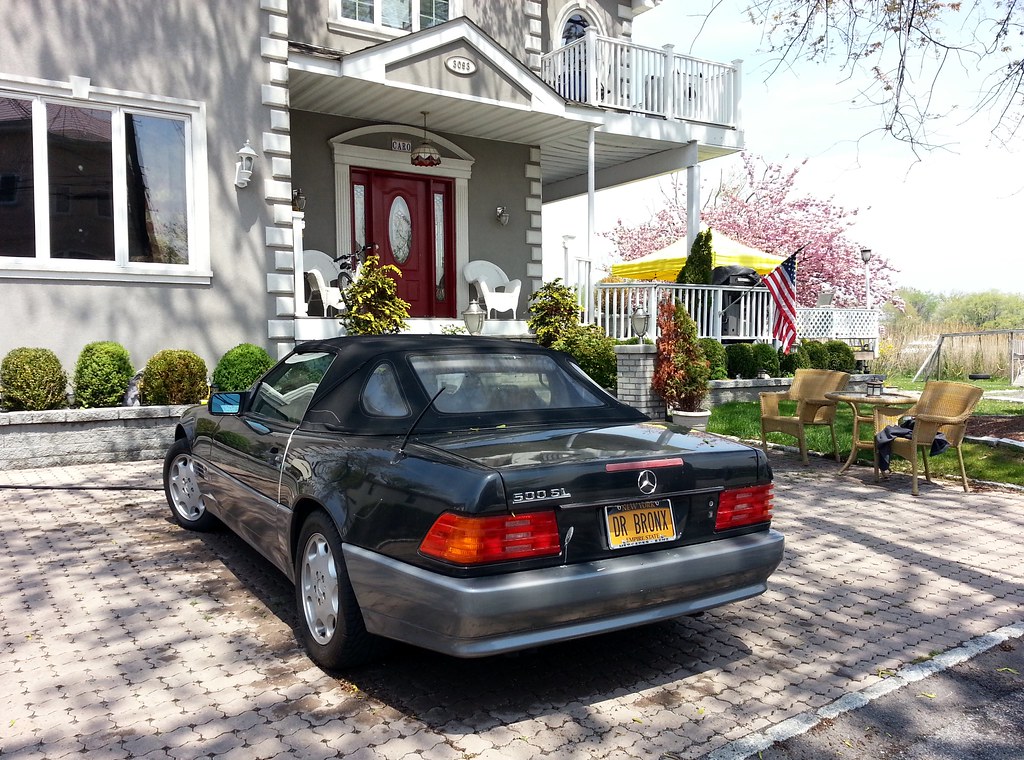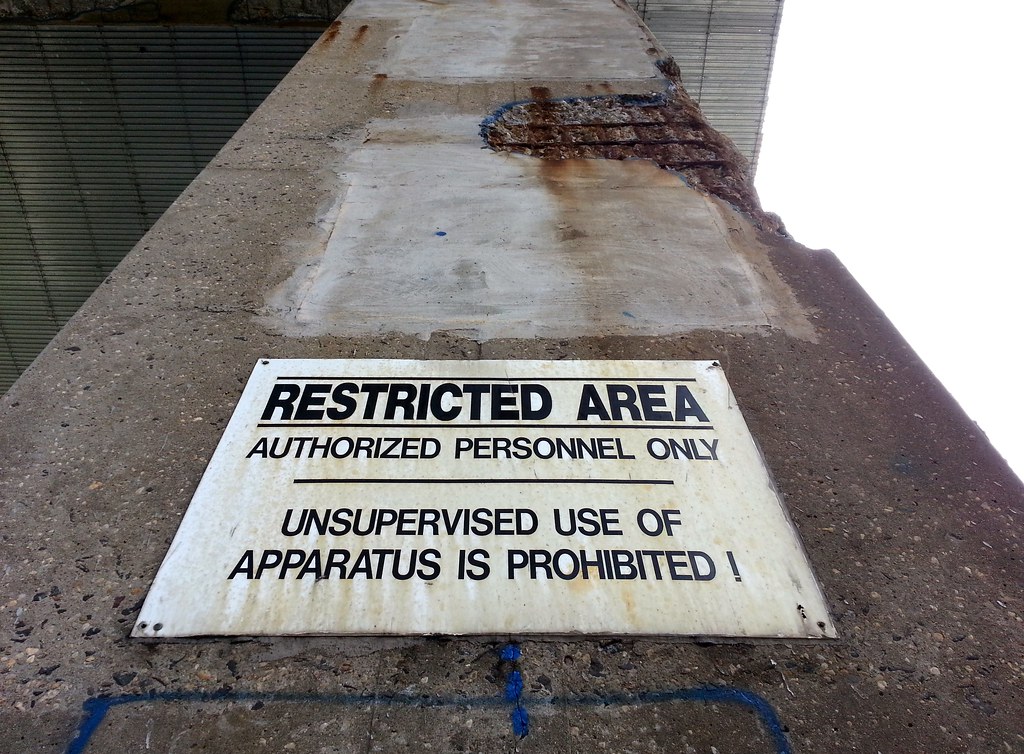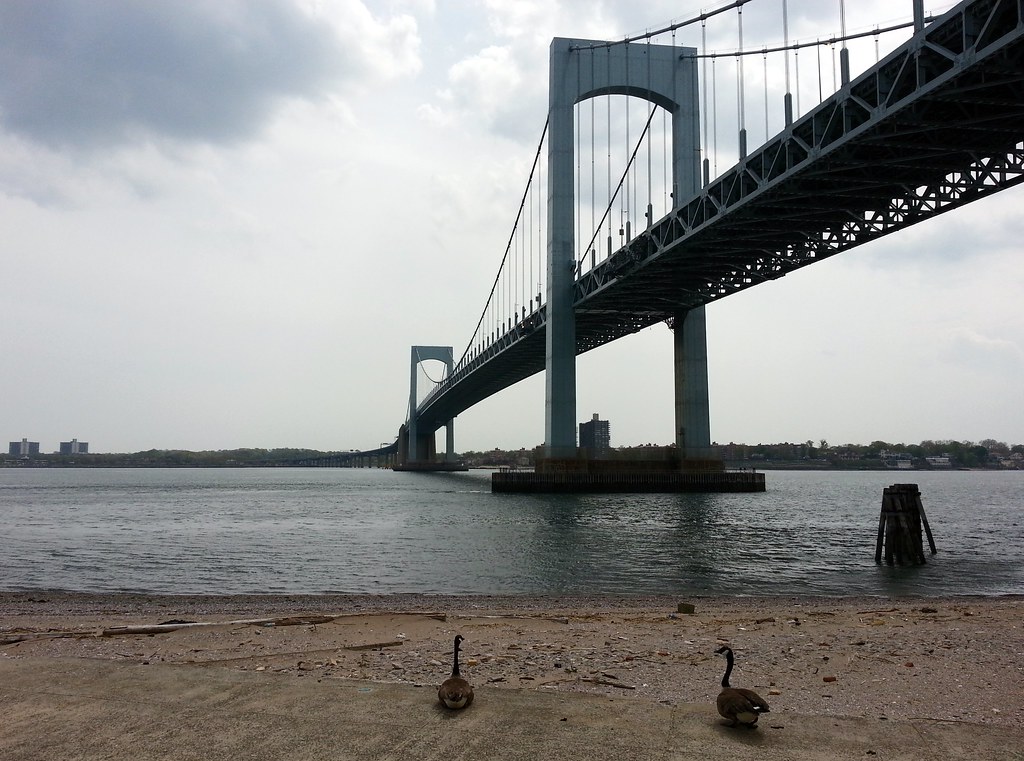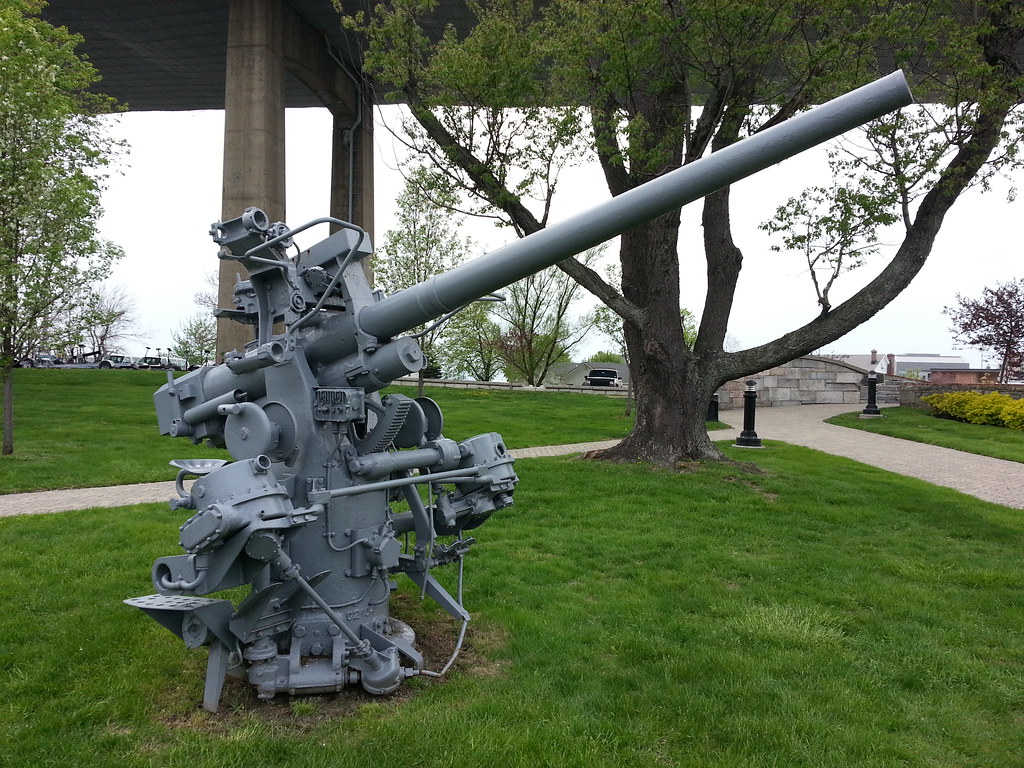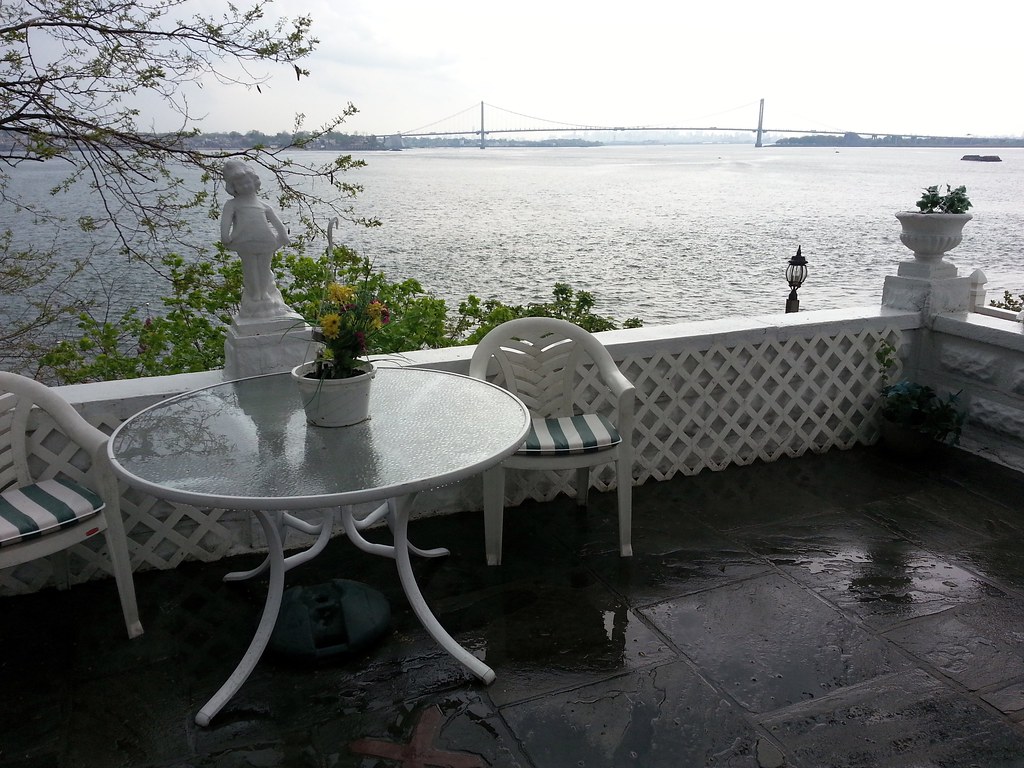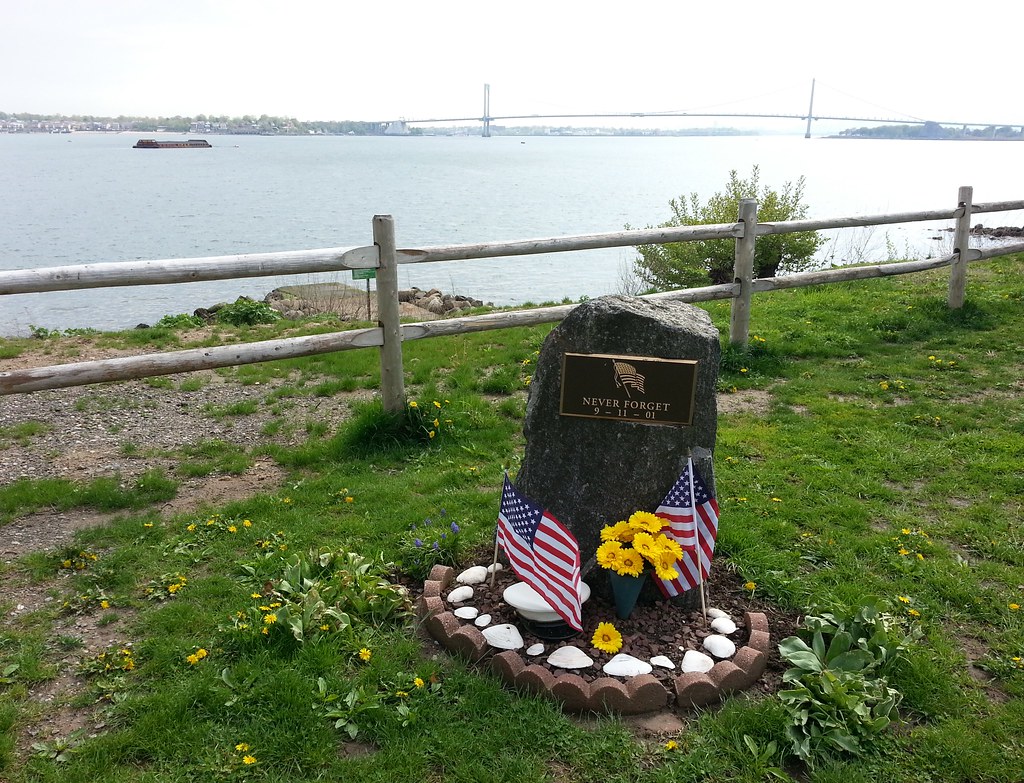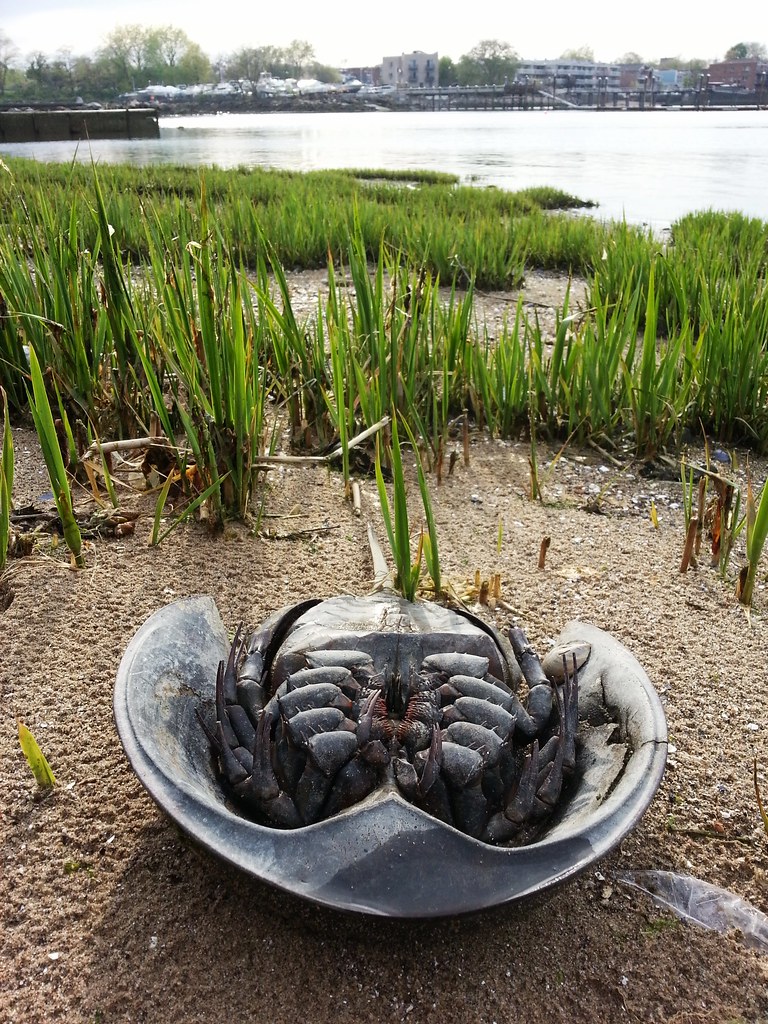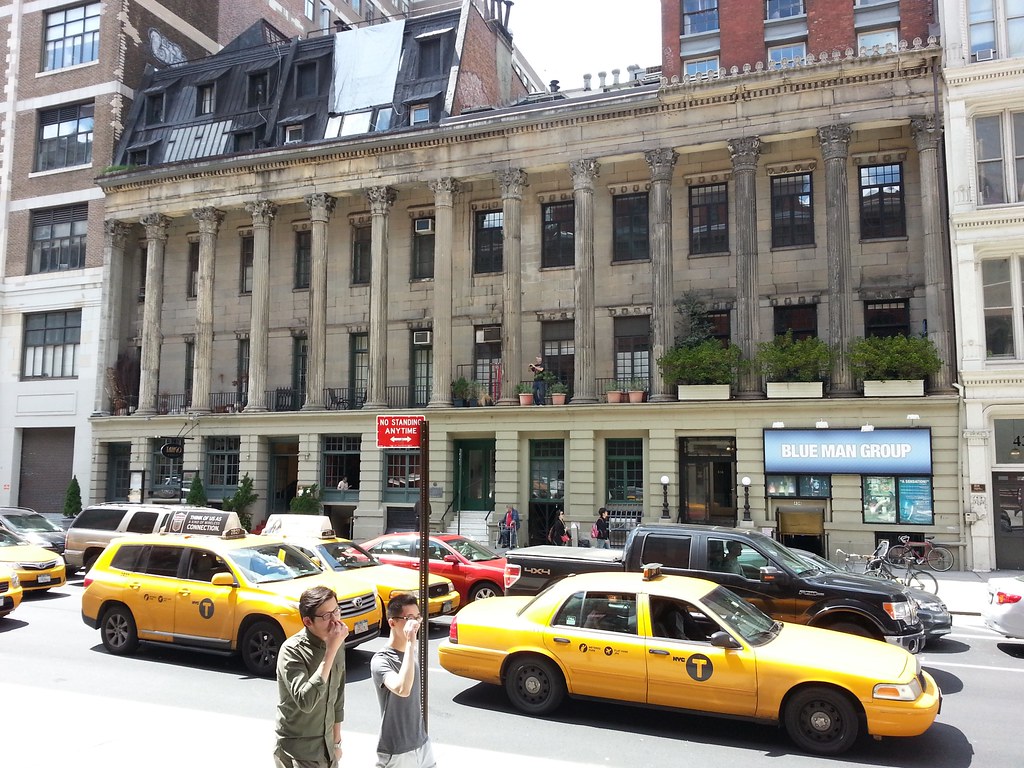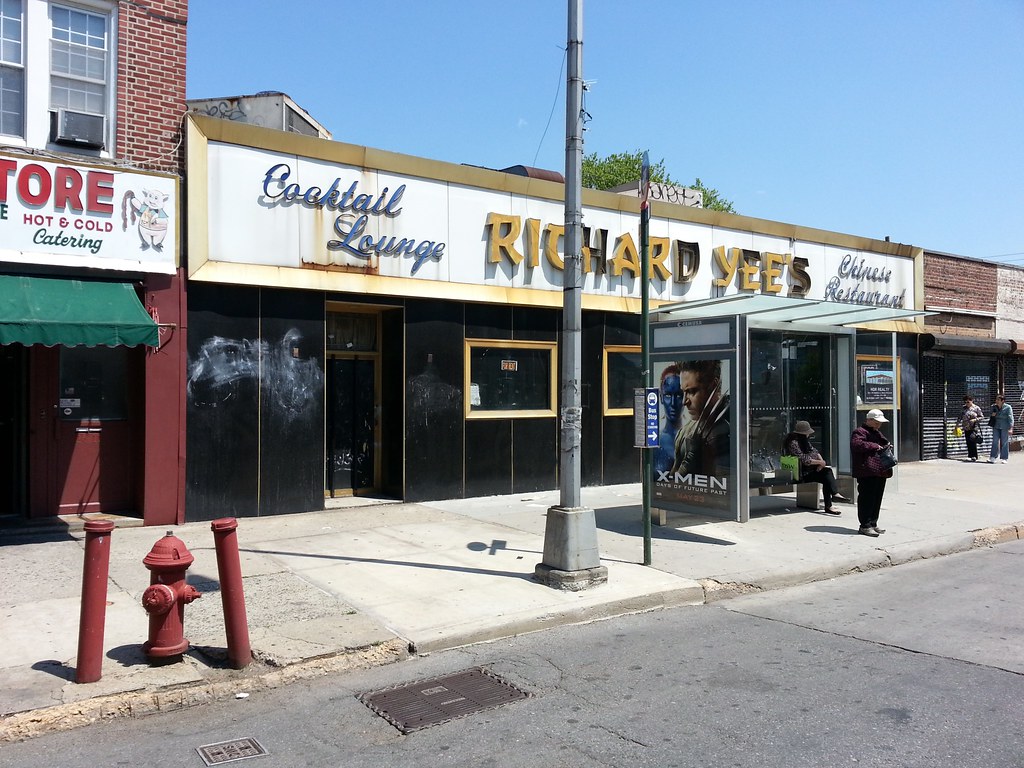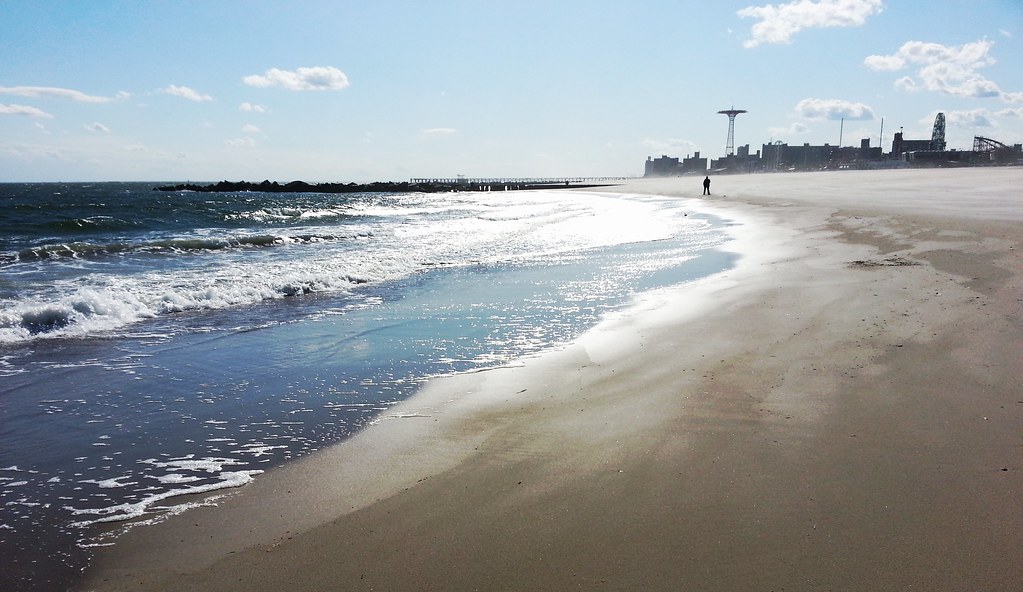
Towering in the background is the long-defunct Parachute Jump, an amusement ride relocated to Coney Island from the 1939-40 World's Fair. Just last year, the Parachute Jump's lighting scheme was given a $2 million upgrade — check it out!

In 1916, Nathan Handwerker opened a frankfurter stand here at the corner of Surf and Stillwell Avenues in Coney Island. From that point on, for over 96 years, this flagship Nathan's reportedly opened for business every single day until it was finally forced to close by Hurricane Sandy. (Damage from the storm kept the place shuttered for several months.)
From a previous post about Charles Feltman, the purported inventor of the hot dog:
Feltman died in 1910, but his restaurant stayed in business, and it was a few years later that a young Polish immigrant named Nathan Handwerker found work there slicing rolls. Supposedly with some encouragement and borrowed money from his then-unknown co-workers Eddie Cantor and Jimmy Durante, Nathan opened his own hot dog joint in 1916 at the corner of Surf and Stillwell Avenues, where he and his wife served up frankfurters for just a nickel apiece, half the price his former employer charged.
According to legend (and Nathan's grandson), with some variations from one telling to another, people were initially skeptical about the quality and contents of a wiener that could be sold for a mere five cents. To alleviate these concerns, Nathan hired people to dress as doctors and eat hot dogs in front of his stand, giving the impression that medical professionals considered his food perfectly healthy. Before long, with the arrival of the subway in Coney Island (and with the terminal station located right across the street), the dogs started selling like crazy, and now, almost a century later, Nathan's Famous remains a household name.
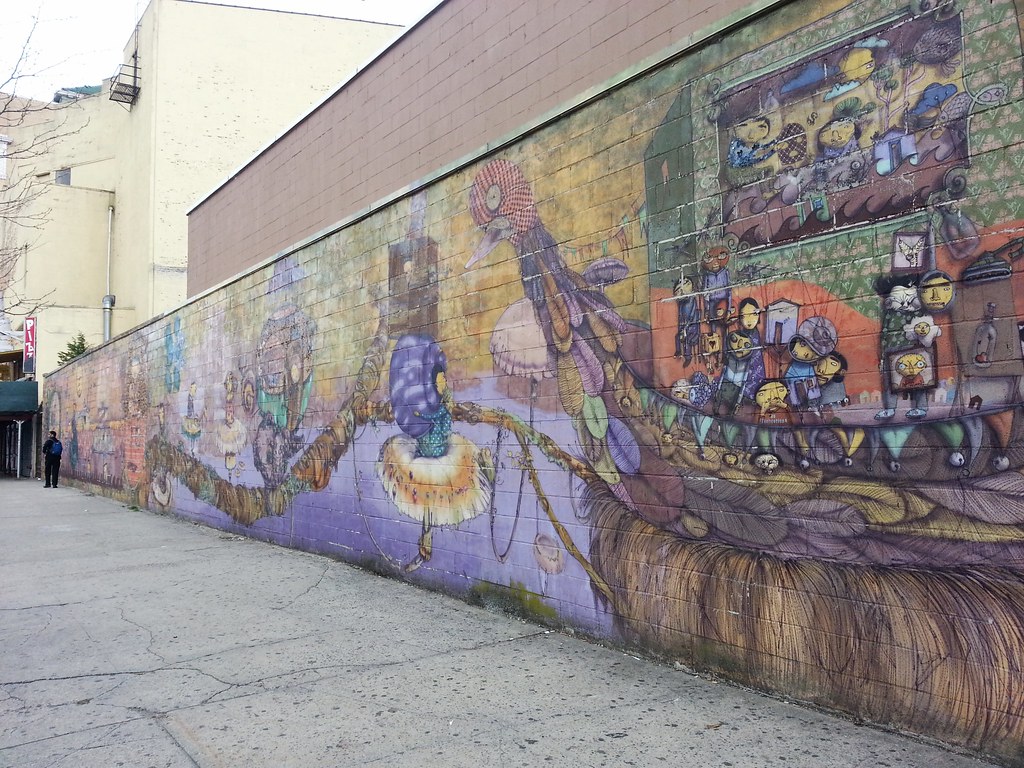
Os Gêmeos, identical-twin artists from Brazil, painted this eerily fanciful mural across from the Coney Island subway terminal back in 2005. For a much clearer view, check out this stitched-together image of the entire wall.
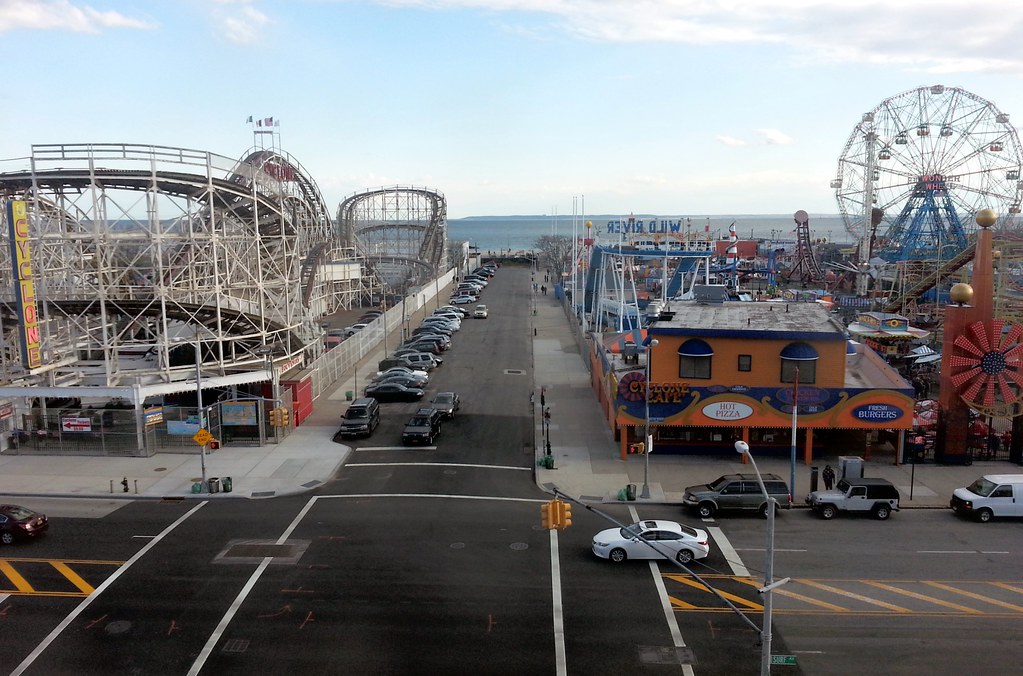
That's the Cyclone at left and the Wonder Wheel at right. I wasn't actually walking when I took this photo (don't tell); I was heading home on the Q train at the end of the day.

past the old Troop C Armory on Bedford Avenue in Crown Heights. This and the next few images are from a short unofficial stroll around the neighborhood.
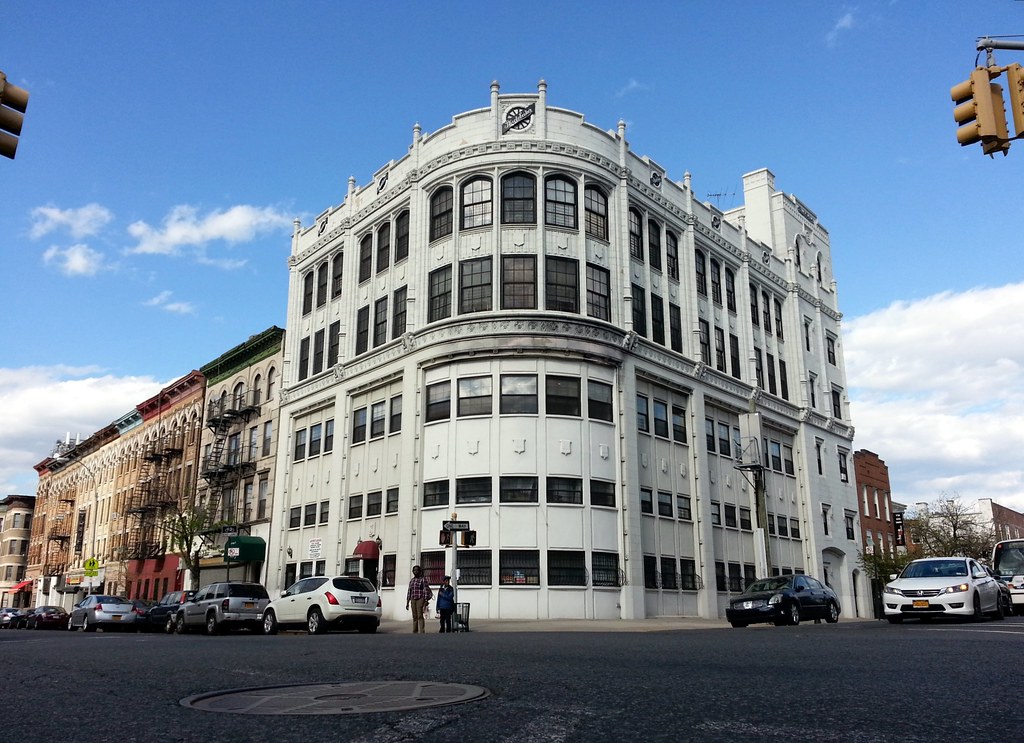
Erected in 1920, this former Studebaker showroom (circa-1942 photo) dates back to the days when this stretch of Bedford Avenue was known as Automobile Row. The building has since been converted into low-income apartments, but some traces of its original occupant still remain, most notably the terra-cotta wheel logos (close-up) at the top of the facade. Perhaps you recall seeing those same logos on an old Studebaker finishing facility up in Manhattanville a couple of months ago.
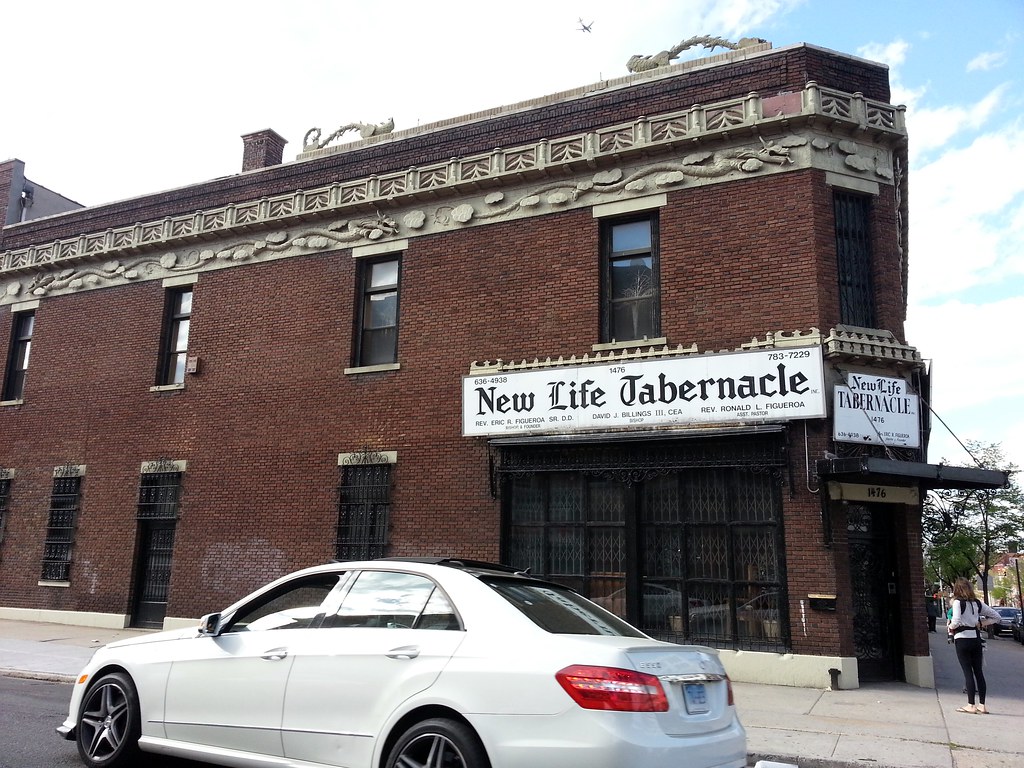
Like the Studebaker Building that stands across the street, this two-story brick structure was once an automobile showroom. (It looks more showroom-like from the other side.) It later — some sources say 1929 or 1930, but ads from 1932 still list an auto dealer at this address — became the home of Loehmann's, the legendary discount designer women's clothing store started by Frieda Loehmann after her flutist husband's paralyzed lip left the family in need of a stable income.
At first glance, the building is nothing to write home about, but then you start to notice a few things, like the dragons flying through the clouds on the frieze. Mrs. Loehmann had a fondness for such over-the-top ornamentation; in fact, the place looked even more outlandish in its heyday — take a peek at what's hidden beneath those church signs. And the interior was a sight to behold as well:
Hundreds of racks of clothes failed to dim the theatrical splendor inside. The decor was compounded of marble floors from Italian palazzos, antique Italian wall paneling, huge Italian marble statues and junk that Mrs. Loehmann couldn't resist from Seventh Avenue showrooms that closed. Her chairs were all covered in old fur coats. She had a leopard sofa with nutria.Not to mention the "chandeliers, dripping prisms, enormous paintings, Venetian columns festooned in gold, lions in iron and lions in marble, huge lanterns and torchieres with figures holding clusters of lights aloft". All of these furnishings were auctioned off in 1962 after Mrs. Loehmann died, but many of them were acquired by a clothier named Martin Kogut who restored much of the decor when he opened his own store in the building. Here are three grainy photos of the interior of his store in 1966, along with other pictures of the building in different eras. As you can see in a couple of those shots, the church that currently occupies the place decided to retain some of the decor.
One might suspect that Mrs. Loehmann intended the lavish furnishings to imbue the shopping experience with an air of refinement, but the actual scene at her store was apparently rather primal, with women aggressively competing to find the best bargains and stripping down in the open to try on the merchandise — there were famously no dressing rooms at Loehmann's. (The Loehmann's stores that recently went out of business were an offshoot of Mrs. Loehmann's standalone establishment, but they also offered communal changing areas.) Here's how a reporter for the Brooklyn Daily Eagle described his trip to Loehmann's with his wife in 1954:
Loehmann's, on Bedford Ave. — with its stained glass peacocks and carved dragons — looks from the outside like the pleasure dome of Kubla Khan. Inside, it has much the same atmosphere as a capsizing ferryboat. . . .
[Women] invade the place daily in ravening hordes to peel non-chalantly before a gallery of gaping husbands and do battle for the prizes hidden away among the dress racks. . . .
In a small arena walled by dress racks, a battalion of frenzied females was stripping off its outer garments and mounting an assault wave on Mrs. Loehmann's wares. Some of the women were practically stripping one another.
A few of the lady shoppers, to the special satisfaction of the spectators' gallery, were wearing two-piece affairs and I even caught a couple of glimpses of black lace.
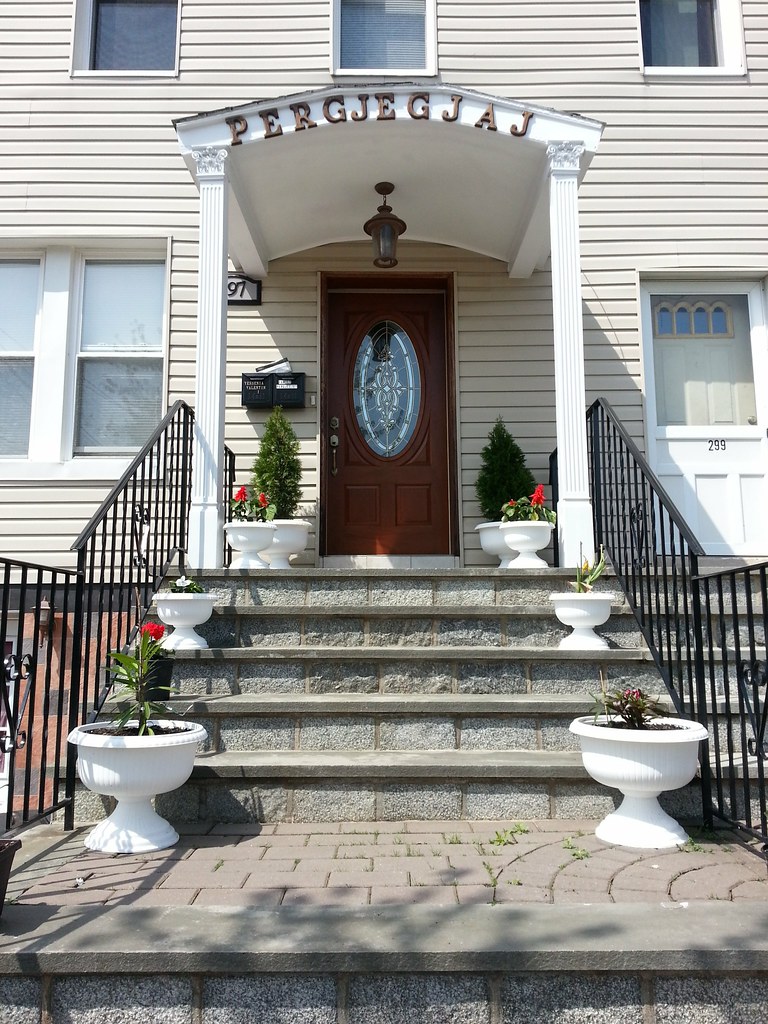
Speaking of such names, the Bronx is home to tens of thousands of Albanian-Americans. While searching for information on this subject, I came across two interesting articles: 1) a 2001 piece about the dozens of Italian restaurants in the NYC metro area that are actually run by Albanians, and 2) a 1999 story about local Albanians preparing to enlist as volunteers in the Kosovo Liberation Army:
Scores of them, from youths barely out of high school to grizzled men old enough to be their grandfathers, jammed [Frank's Sport Shop on East Tremont Avenue] to buy fatigues, pistol belts, compasses, boots and night-vision binoculars. Duty dictated that they fight for a place some of them had never visited or a country others left decades ago.
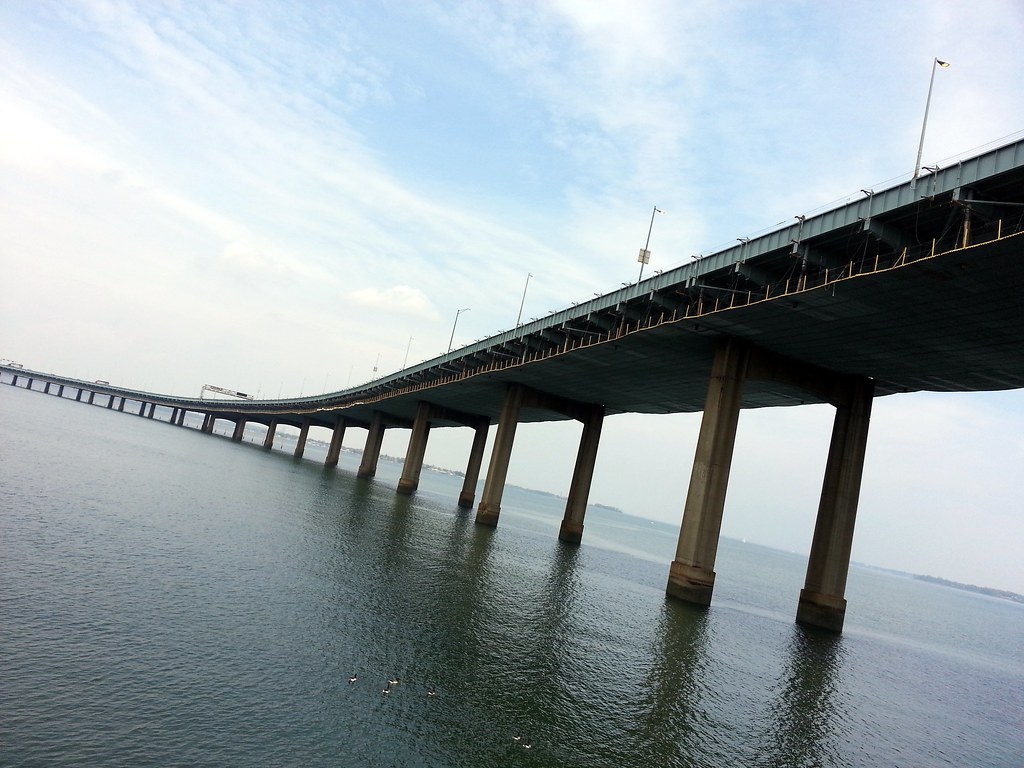
The long, curving approach on the Bronx side of the Throgs Neck Bridge
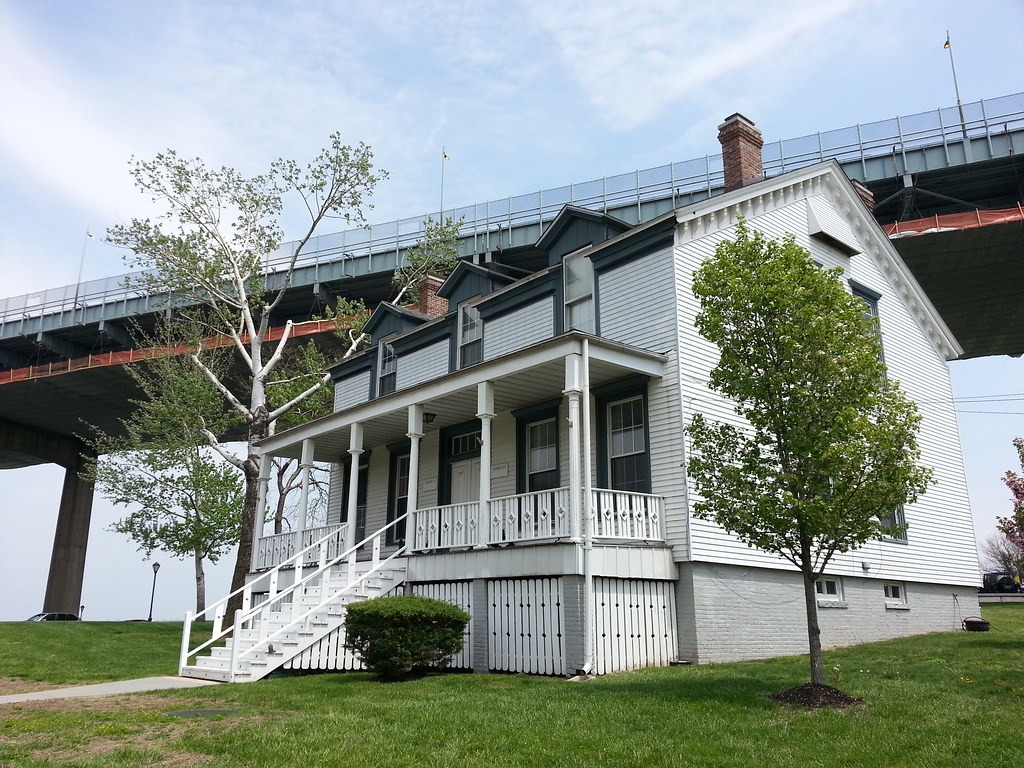
This is one of four handsome houses standing in a row on the grounds of old Fort Schuyler, where perhaps they were once officers' quarters. The fort and the surrounding property now serve as the campus of SUNY Maritime College, and the houses are currently used as faculty residences. There was originally a fifth house standing to the left of this one (compare a 1924 aerial photo to a 1996 photo), but it was knocked down to make way for the Throgs Neck Bridge.

This 60,000-pound propeller on display at SUNY Maritime College originally belonged to the SS United States, the fastest trans-Atlantic ocean liner ever built. According to the NY Times, it "was built for speed because it was meant to be a troop carrier if needed. The Pentagon paid two-thirds of its $78 million construction cost."
The ship has been out of service since 1969 and moored at a Delaware River pier in Philadelphia since 1996, but it looks like it may be moving back home to New York in the not-too-distant future to serve as "a hotel, museum, shopping and restaurant mall, entertainment complex, conference center, educational facility, or some combination of all options for reuse."
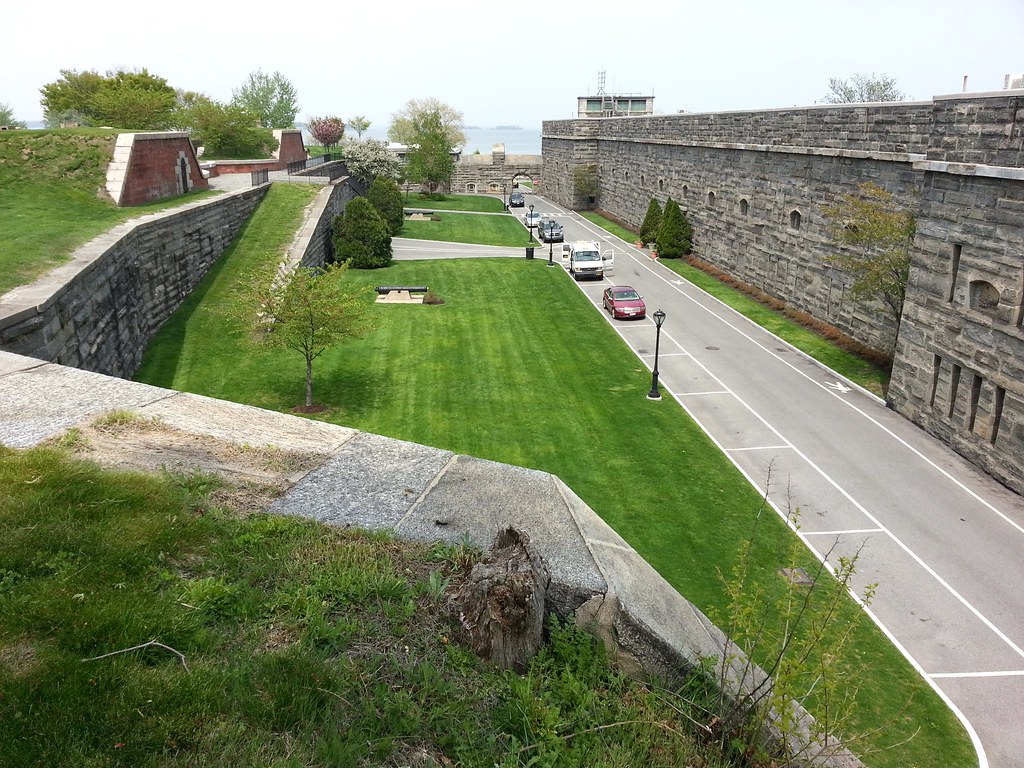
Fort Schuyler, at right, is a pentagonal stone fort built in the mid-19th century at the tip of the narrow Throg(g)s Neck peninsula in the Bronx, where the East River meets Long Island Sound. Along with Fort Totten across the water in Queens, Fort Schuyler was positioned to defend the entrance to the East River against enemy naval forces trying to reach New York Harbor. Check out this awesome aerial view, and this more pragmatic map, to get a sense of the area's geography.
The fort never saw any combat, but it was quite active during the Civil War, when troops were trained here and a hospital and prison opened on the grounds. By the 1910s, however, the fort was considered obsolete, and the Army finally decided to abandon it around 1931. After a lengthy reconstruction by the federal Works Progress Administration, the property was dedicated as the new home of the New York State Merchant Marine Academy (now SUNY Maritime College) in 1938, and it still serves as the school's campus today. In addition to the conventional college buildings found here (campus map), the fort itself has actually been converted into academic space. It contains a library and the expansive Maritime Industry Museum, as well as classrooms and offices — a pretty impressive reuse of an old 19th-century fortification!
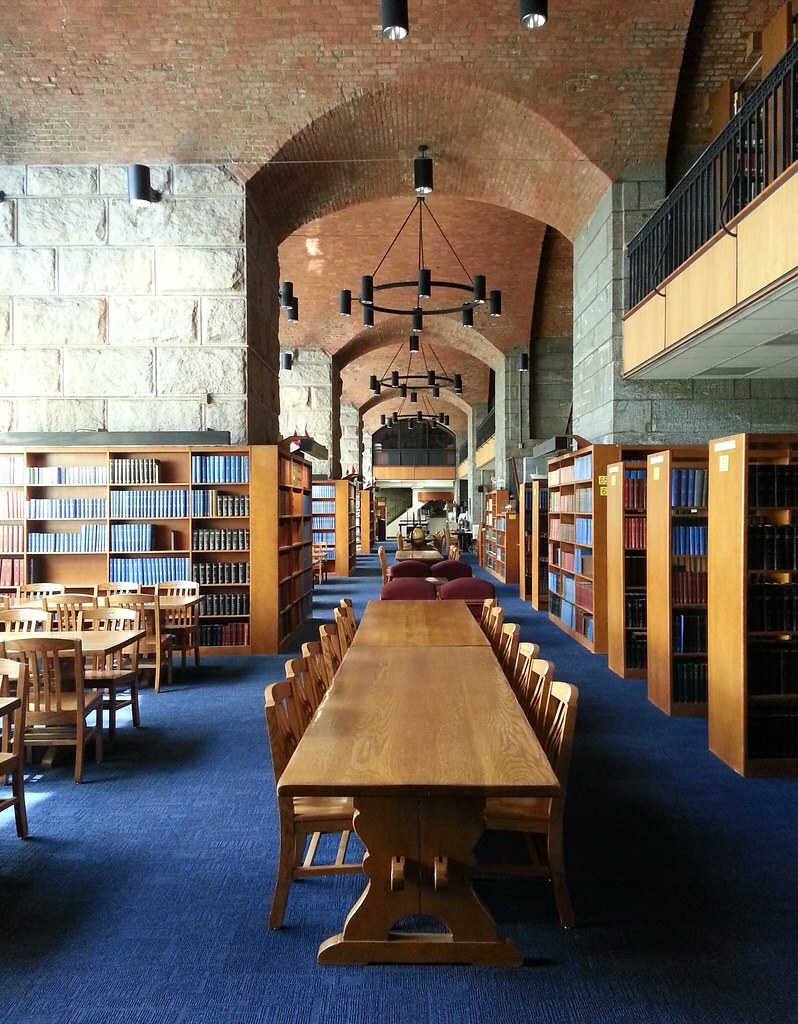
Along with the Maritime Industry Museum and some classrooms and offices, this library is located inside old Fort Schuyler at SUNY Maritime College.
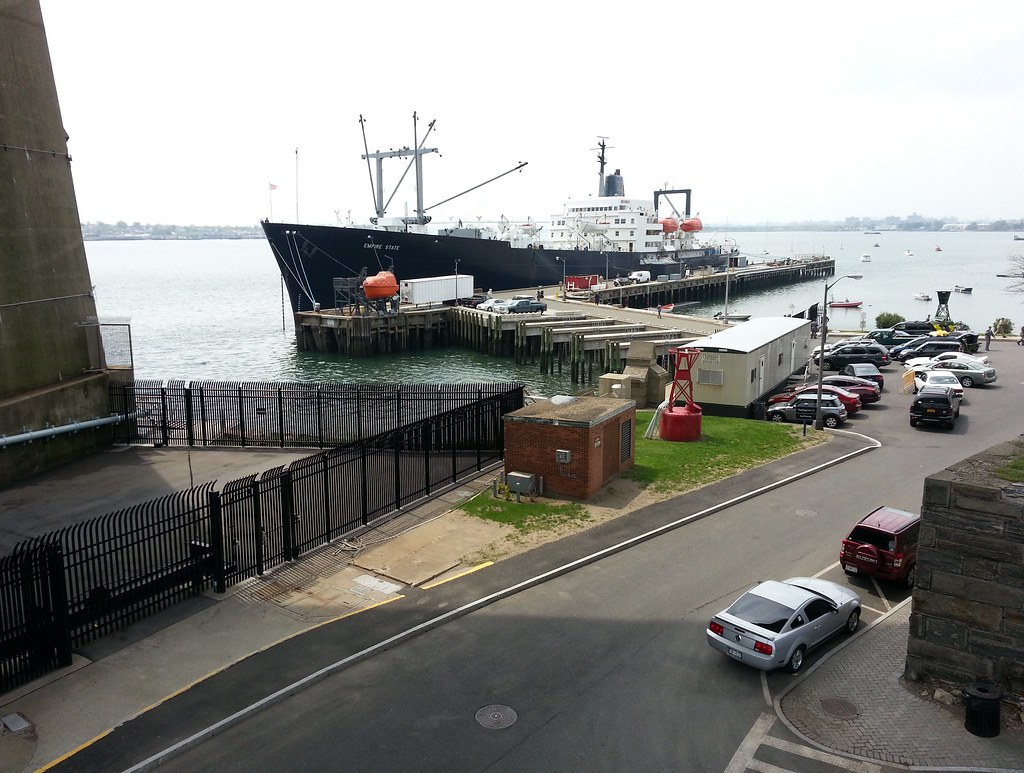
This former freighter has been SUNY Maritime College's training ship for the past quarter-century. In this photo, it's just two days away from departing on this year's three-month-long Summer Sea Term voyage to Baltimore, Philadelphia, the Canary Islands, Ireland, Denmark, and Portugal.
As part of the nation's Ready Reserve Force, the ship has also been called into duty on a few occasions during its time here at SUNY Maritime, once to bring American troops back from Somalia in 1994, and twice to provide housing for relief workers in hurricane-stricken areas (New Orleans after Katrina and New York after Sandy).
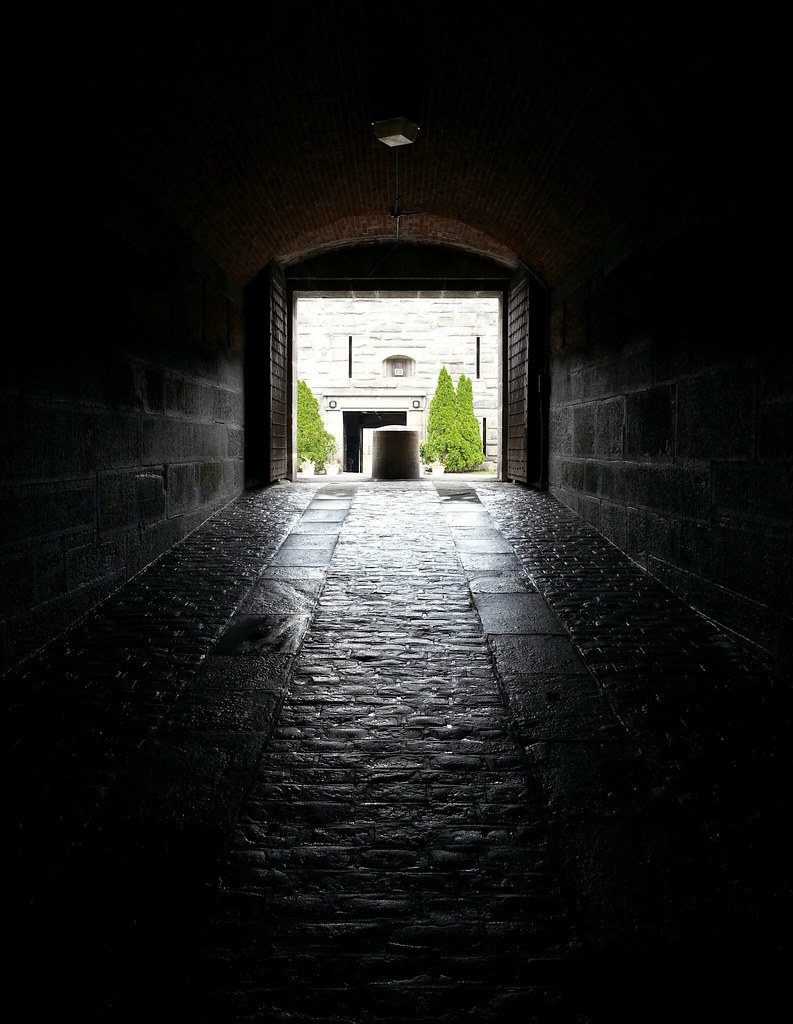
Passing beneath Battery Gansevoort, just outside the walls of Fort Schuyler
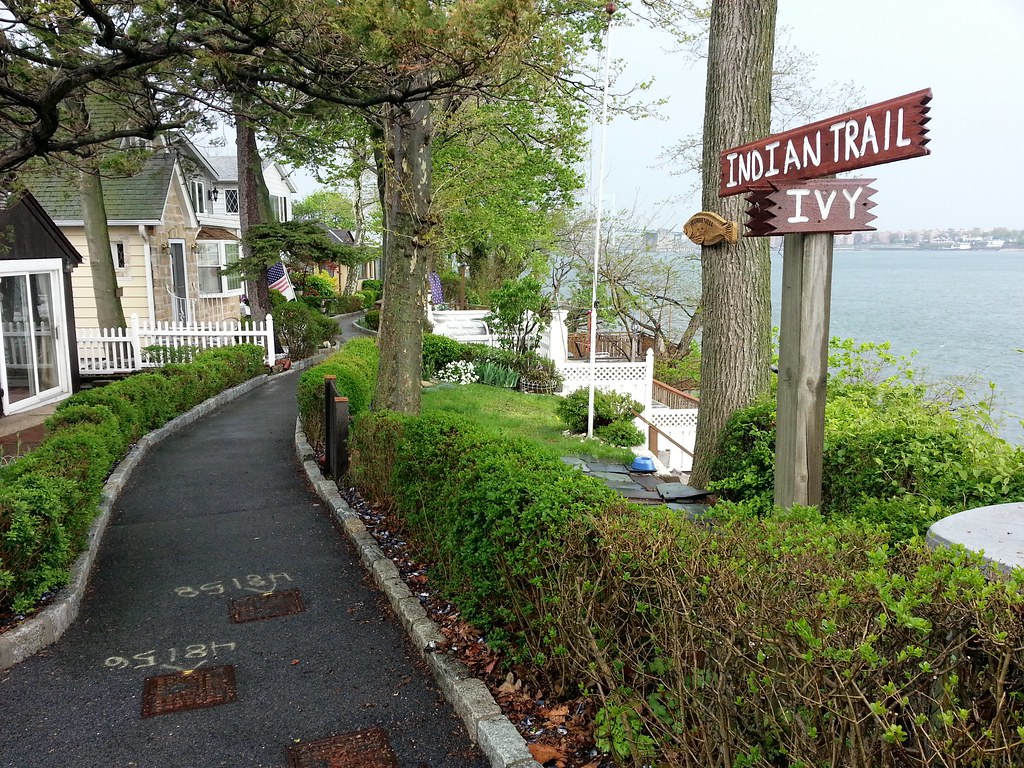
This ridiculously quaint path runs along the western edge of Silver Beach Gardens.
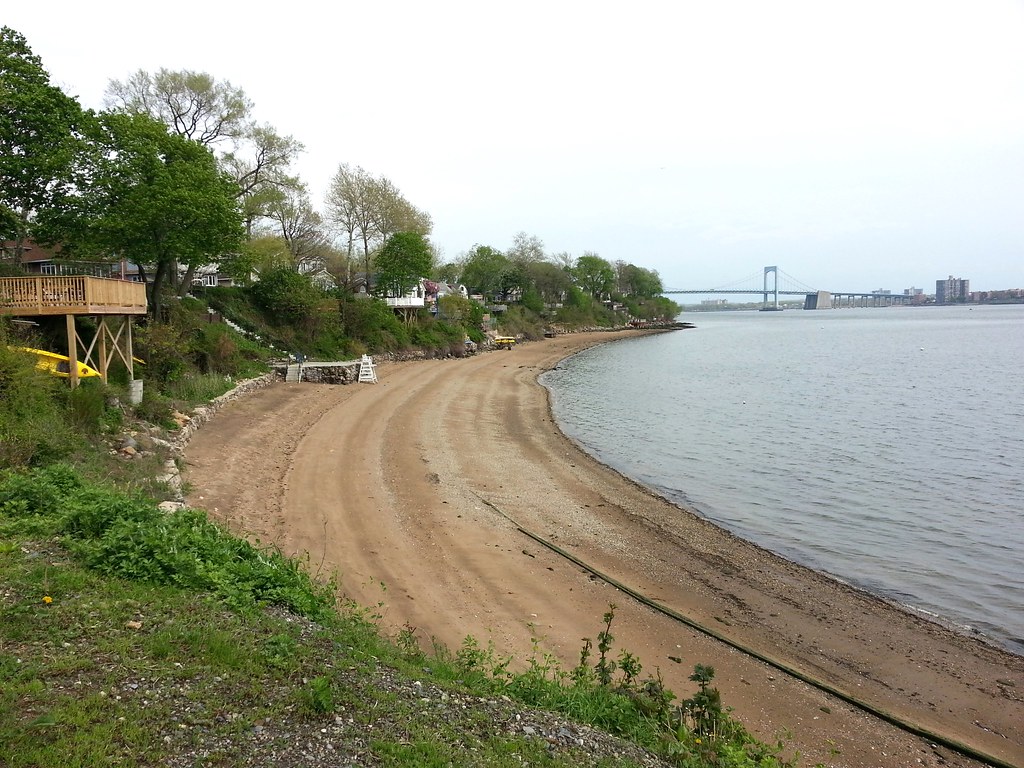
As you can see, the houses of Silver Beach Gardens sit on a bluff up above the beach. Facing this direction (southeast), you can see the Throgs Neck Bridge in the distance.

Here we are one last time in Edgewater Park, where there seem to be just as many little pedestrian alleys as there are roads. Some background on the neighborhood from the NY Times:
In 1923, when Richard W. Shaw Sr., the first of four generations of Shaw landlords, bought the property, only one house stood out: a great stone mansion that overlooked pastures, swamps and, of course, the water.
During the summer he permitted church groups, Boy Scouts and, later, workers from New York City to pitch tents or build rustic cottages on what became known as Edgewater Camp.
"As kids, we'd go see cows grazing and then go down to the farmhouses nearby and steal tomatoes and squash," said John McNamara, a 72-year-old Bronx historian and former Edgewater resident, who recalls lazy summers of courting schoolgirls in canoes and walking three miles to the nearest trolley into town.
"We lived in wooden-sided tents with canvas tops," he said. "We had no electricity, just kerosene stoves. It was a real pioneer community."
In the 1930's, the Great Depression forced many of the summer residents to sell their homes in the city. They winterized their Edgewater bungalows with newspapers, cardboard boxes and other crude insulation. A permanent community was born.
For all its scenic beauty, Edgewater is a planner's nightmare, with neither building codes nor zoning laws. Fire hydrants sprout in backyards, a reminder of how the early residents simply ignored the street grid the city had planned for them.
The result is a jumble of 675 single-family houses shoehorned into 55 acres of land, elbowing one another on 30-by-50-foot plots.
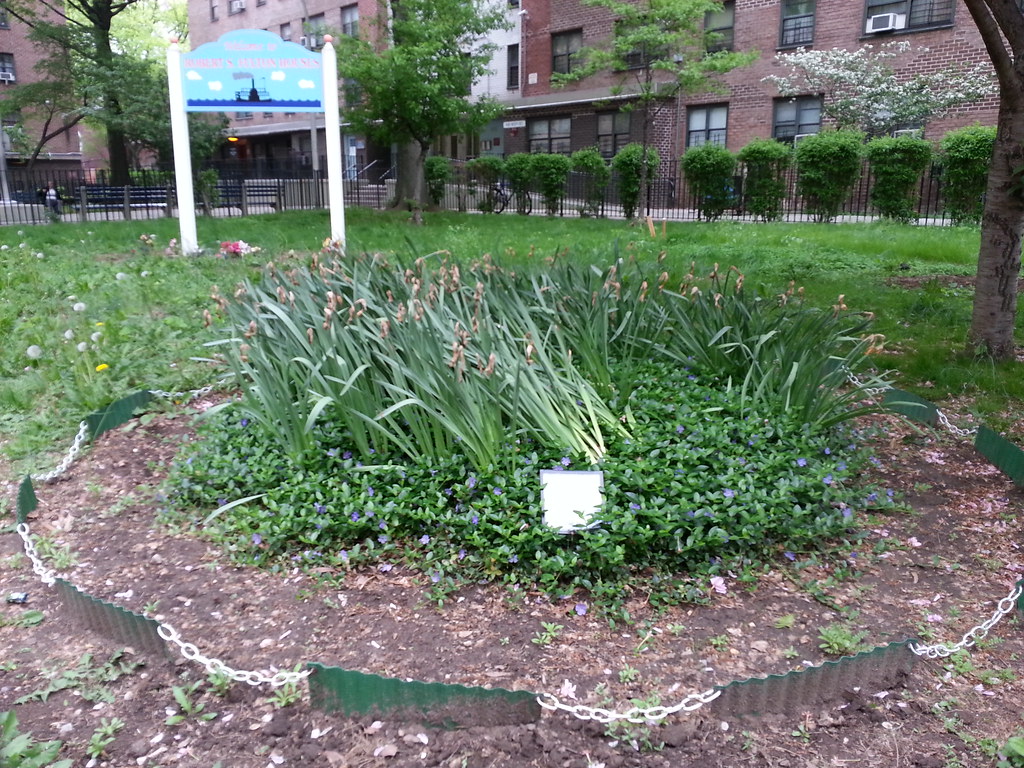
I was just out for a quick stroll when the little white sign in the flower bed here at the Fulton Houses in Chelsea caught my eye. It reads:
Daffodils
In memory of those who perished
at the World Trade Center
on September 11, 2001
A gift of the people of the Netherlands
for the people of New York
Vinca Minor - periwinkle
When it was built in 1833 Colonnade Row was the biggest thing in New York since the British occupation, a 200-foot-long sweep of glistening white marble in the form of a Corinthian colonnade, nine houses combined into one great Greek revival statement on what is now Lafayette Street, opposite the Public Theater.Read the rest here!
But five of the houses were destroyed early in the last century, and their graceful fluted columns and Corinthian capitals were carted away, vanished from the city with the dust of demolition. Vanished, that is, until a garden designer and a Benedictine monk solved the decades-old puzzle of a mysterious Lost City in the woods of a New Jersey monastery.
The rightmost house in Colonnade Row is currently home to the Astor Place Theatre, where, as you can see, the Blue Man Group performs. Here's an NY Times piece (with lots of photos) about a guy named Sturgis Warner who moved into a 700-square-foot apartment in the little brick addition built on top of that house back in 1978, when it was a mouse- and roach-infested wreck. He fixed up the place and designed and installed all sorts of clever space-saving devices to make the most of the room he had. In exchange for his work, the landlord only made him pay $250 per month in rent.
By the time the article was written in 2009, he was still only paying $500 per month! (I don't know much about paying rent in New York, but the place would go for several times that amount on the open market. Anyone have a better estimate?) The producers of the Blue Man Group had bought the building in 2001, however, and were looking to kick him out so they could take over the whole place as their own living quarters. I have no idea what's transpired since then, although there is still a whitepages.com listing for Mr. Warner at this address, for what it's worth.
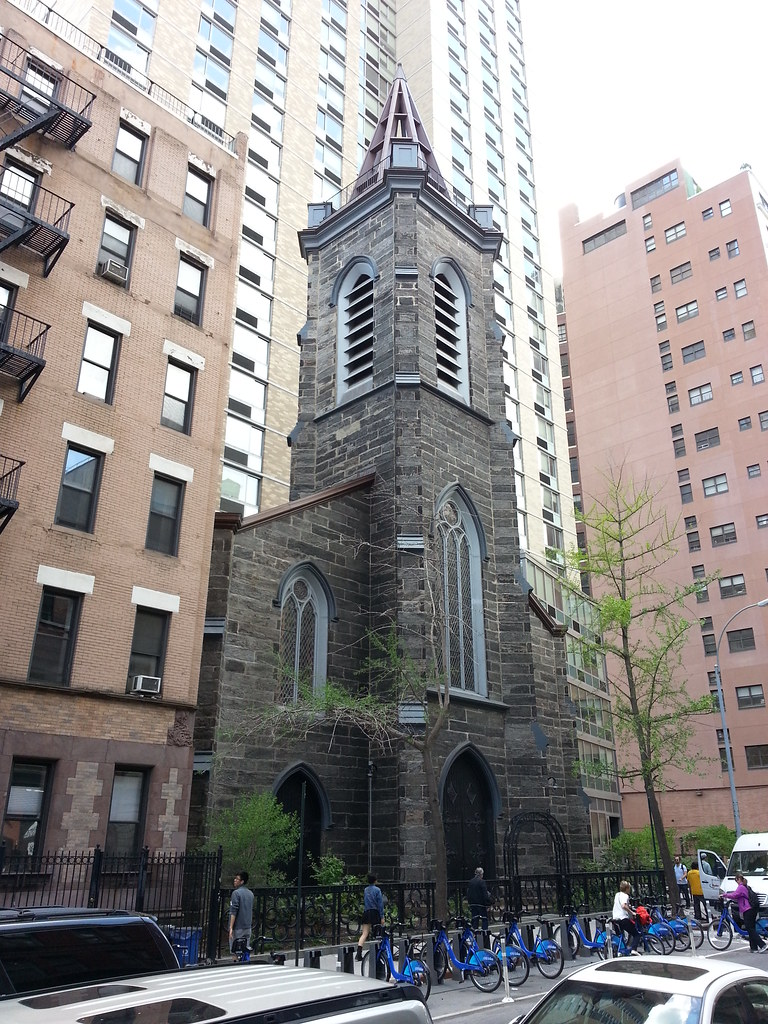
It used to be a church, at least. What you can't quite see in this photo, but which is much clearer from the other side, is that the facade is the only part of the structure still standing. The rest, erected in 1870 by St. Ann's Roman Catholic parish (the church became St. Ann's Armenian Catholic Cathedral in 1983), was demolished in 2005 to make way for the 26-story NYU dorm standing behind it, the tallest building in the East Village. (Not long after the dorm was put up, the City Council approved a rezoning plan limiting building heights in the area to about 12 stories.)
This was actually an example of history repeating itself, to a degree. The extant facade dates to 1847, when the original church on the site was built by the 12th Street Baptist Church. (The building later became a synagogue, home to Congregation Emanu-El.) But in 1870, leaving the facade in place, St. Ann's tore down the rest of the structure and replaced the sanctuary with a new one, which was then in turn replaced by the dorm some 135 years later.
As you might imagine, many neighbors and preservation-minded people were upset with the destruction of the church's body and the subsequent construction of such a bland-looking behemoth in its place. I like the overall effect though, specifically the weirdness of there being a 19th-century stone church facade standing, for no apparent reason, in front of an insipid 21st-century apartment tower. The facade is now effectively a piece of public sculpture and something of an architectural folly (meaning "a whimsical or extravagant structure built to serve as a conversation piece, lend interest to a view, commemorate a person or event, etc."), which I think probably encourages more passersby to interact with it than ever did with the church when it was still intact.

After leaving the FBI, but before becoming a Staten Island Congressman, Michael "I'll break you in half — like a boy" Grimm opened a health food joint on the Upper East Side with the same name as the unrelated establishment pictured above. He was recently indicted in federal court on a slew of charges stemming from his time running the restaurant; he is accused of underreporting wages and revenue, hiring undocumented workers, and lying under oath in a lawsuit brought by his employees. He has publicly described the investigation into his business practices as a "vendetta" and a "witch hunt". I say drop the charges, but throw him in jail for picking such an awful name for the place. Healthalicious? And the slogan ("better than delicious") only makes things worse.
(Here's Jon Stewart's take on the name.)

I was confused by the clown face at the far left. Does it have anything to do with 9/11? Did someone just paint it on top of the memorial mural? I checked Street View, and the clown is there in the oldest photo, which dates back to October 2007. If it were an act of vandalism, you'd think someone would have painted over it in all the years since.
It turns out that it's the logo of the Fun House, a disco club that was open from 1979 to 1985 on West 26th Street in Manhattan. The place was popular with young people from here in Sheepshead Bay as well as several other outer-borough neighborhoods. Joe Indart, the guy who created this and many other southern Brooklyn 9/11 murals we've come across, had apparently painted a Fun House mural at this street corner before 9/11 ever happened. So, it would seem, what you see above is simply a combined memorial to the loss of lives and the loss of youth.
Yee's represented a new type of restaurant when it opened in 1952: Emphatically located nowhere near any Chinatown, it offered a nightclub ambiance with the Polynesian flourishes that were expected of upscale Chinese restaurants at the time, including flaming cocktails, tiki-hut décor, a separate cocktail lounge, and an evolved Cantonese cuisine perfectly suited to the young families that were flooding the neighborhood in the postwar era. Classic dishes included sliced roast pork with garlic and sherry, steak kew, lobster in scallion sauce, and some of the city's first "sizzling platters." Sadly, the restaurant closed in 2008, and the space will undoubtedly be occupied by some sort of fast-food establishment in the future.Note the animal cannibal on the pork store at left.

Gravesend Neck Road currently terminates at Avenue U. But standing here on the north side of the avenue, you can still make out traces of the road's former right-of-way continuing its diagonal path northeast through the otherwise rectangular street grid. This aerial view makes things especially clear.

I didn't realize it at the time, but this used to look like this.

From the website:
• Robotic Employee that is Ready to Work For You 24/7Compare to Robowaver.
• No Vacation Time or Breaks. Ever.
• No Complaining, Phone Calls, Texts or Slacking off
• 100% in Your Control
• No Insurance, Liability or Workers Compensation
• No Paying $2880 for a Full Time Sign Spinner (12 hrs a day, $8 per hour, 30 days)
• No Having to Deal With Lazy, Incompetent Sign Spinners

